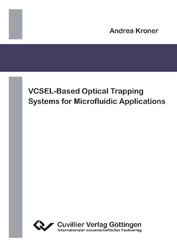| Fachbereiche | |
|---|---|
| Buchreihen (96) |
1378
|
| Nachhaltigkeit |
3
|
| Gesundheitswesen |
1
|
| Geisteswissenschaften |
2365
|
| Naturwissenschaften |
5406
|
| Ingenieurwissenschaften |
1793
|
| Allgemeine Ingenieurwissenschaften | 292 |
| Maschinenbau und Verfahrenstechnik | 862 |
| Elektrotechnik | 686 |
| Bergbau- und Hüttenwesen | 30 |
| Architektur und Bauwesen | 75 |
| Allgemein |
98
|
|
Leitlinien Unfallchirurgie
5. Auflage bestellen |
|
Erweiterte Suche
VCSEL-Based Optical Trapping Systems for Microfluidic Applications
Andrea Kroner (Autor)Vorschau
Inhaltsverzeichnis, Datei (38 KB)
Leseprobe, Datei (190 KB)
Optical trapping and manipulation by laser beams offers the unique possibility to handle
single micrometer-sized particles such as living cells without any mechanical contact,
damage or contamination. A second hot topic in biology is microfluidics, where the examination
of biological samples in channel structures with widths below 100 µm reduces
the used sample volume significantly. While the combination of both techniques results in
attractive lab-on-a-chip structures for particle sorting and analysis, the commonly bulky
trapping setup is contradictory to the miniaturized concept. Here, the use of vertical-cavity
surface-emitting lasers (VCSELs) as light sources in optical trapping systems allows a strong
reduction of the setup complexity owing to the small dimensions, low cost and high beam
quality of these devices.
This thesis gives a detailed study on optical manipulation systems based on vertically
emitting laser diodes. A standard optical tweezers setup as well as a novel, miniaturized
system, the so-called integrated optical trap are investigated. The latter aims for particle
separation and sorting in microfluidics resulting in low-cost, portable modules.
A classical optical tweezers system based on a high numerical aperture objective in combination
with a VCSEL light source is investigated. Standard multi-mode as well as single-mode
surface relief VCSELs are used as laser source. With both kinds of VCSELs, optical trapping
of polystyrene particles of sizes ranging from 4 to 15µm is demonstrated with some
milliwatts of optical power at the sample stage. A maximum trapping force of 4.4 pN for
15 µm particles is achieved with the multi-mode laser, proving the suitability of multi-mode
lasers for optical manipulation despite their inferior beam profile.
By using two-dimensional VCSEL arrays instead of solitary lasers, the system is extended
to a multiple optical tweezers setup in a straightforward manner. To avoid any additional
optics, densely packed VCSEL arrangements with a device spacing of less than 25 µm are
used, where a novel fabrication process allows the seamless integration of the inverted surface
relief technique for enhanced beam quality. By electrical switching between individual
devices of the array, non-mechanical particle translation with velocities of up to 12 µm/s is
achieved. With a tilted linear VCSEL array, an optical lattice is generated in the optical
tweezers setup, and continuous deflection of particles is realized.
By substituting the sample stage in the optical tweezers setup with a microfluidic chip
fabricated from polydimethylsiloxane (PDMS), particle redirection at a channel junction is
realized using a solitary VCSEL source as well as a tilted linear VCSEL array. For the latter,
the particles are deflected when passing the optical lattice, thus, the position of the lasers
is fixed and no moving parts are necessary, which further reduces the setup complexity.
To achieve a drastic miniaturization of the trapping setup, namely the integrated optical
trap, the laser source is placed directly underneath the sample chamber. A weakly focused
laser beam is generated in the particle solution by integrating an additional microlens on
the VCSEL output facet. To determine appropriate lens geometries, the beam propagation
inside the integrated trap structure is calculated and the thermal reflow process for lens
fabrication is studied in detail concerning lens diameter, reflow temperature and substrate
material. By combining the microlens with the inverted relief technique, the quality of the
focused beam is strongly improved with respect to divergence, transverse beam profile and
beam diameter, where a minimum of 7 µm is measured at the focal point. With first solitary
integrated optical traps, deflection, levitation and transverse trapping of 10 µm polystyrene
particles is demonstrated for optical powers of 5mW.
In a next step, integrated optical trap arrays are realized based on closely spaced twodimensional
arrangements of lensed relief VCSELs. To transfer the continuous deflection
scheme demonstrated in the classical tweezers setup to the integrated trap, linear arrays of
parallel working VCSELs are investigated. To support the design of the multiple integrated
trap structure, a simulation of the optical deflection process is performed. Here, a dependence
on the geometric and material properties of the particles is predicted, so applications
in microfluidic particle sorting are intended. Compact and portable modules are obtained
by integrating the laser chip with the microfluidic chip using flip-chip bonding. Although
the finished modules show strong heating of the VCSEL chip resulting in a significant reduction
of the device performance, simultaneous trapping as well as continuous particle
deflection was successfully demonstrated with a total optical power of just 5mW.
The results presented in this work demonstrate the potential of VCSELs as laser sources for
optical trapping and microparticle manipulation. In conventional optical tweezers setups,
the use of VCSELs reduces the setup complexity significantly, while first prototypes of
ultra-compact integrated optical traps based on VCSELs confirm the feasibility of portable
and inexpensive microfluidic sorting systems.
| ISBN-13 (Printausgabe) | 3869556277 |
| ISBN-13 (Printausgabe) | 9783869556277 |
| ISBN-13 (E-Book) | 9783736936270 |
| Sprache | Englisch |
| Seitenanzahl | 164 |
| Auflage | 1 Aufl. |
| Band | 0 |
| Erscheinungsort | Göttingen |
| Promotionsort | Universität Ulm |
| Erscheinungsdatum | 17.01.2011 |
| Allgemeine Einordnung | Dissertation |
| Fachbereiche |
Elektrotechnik
|








